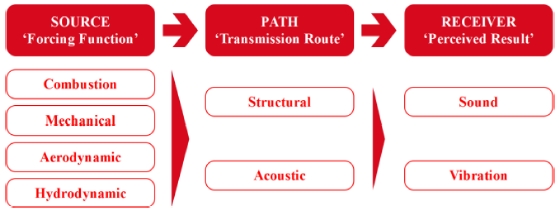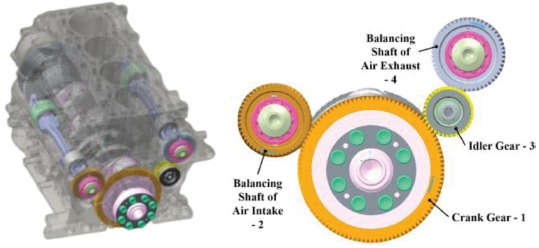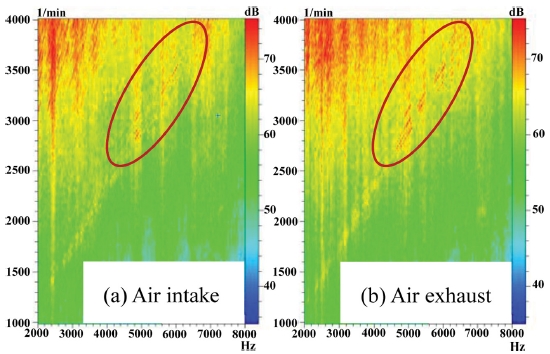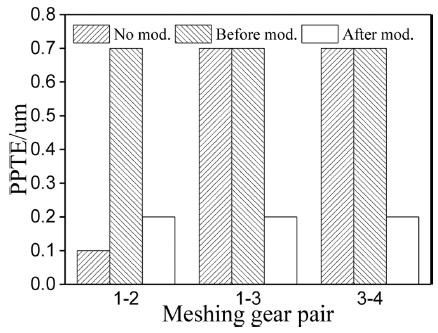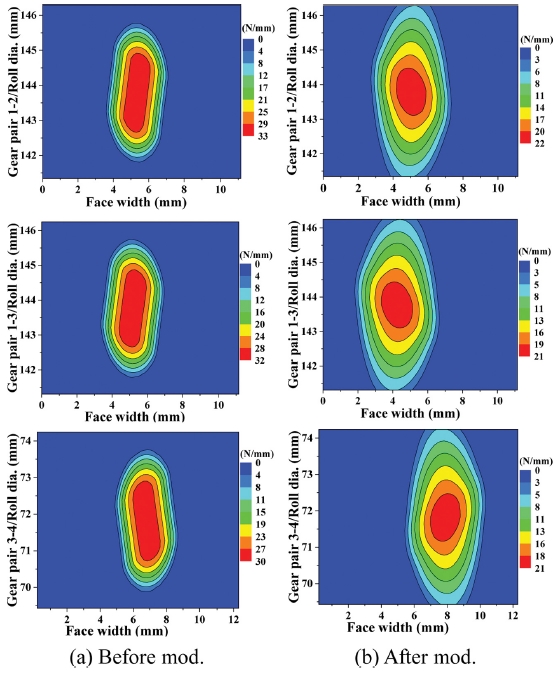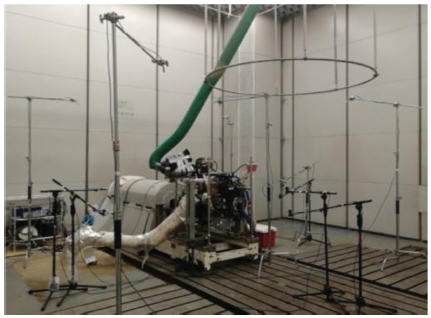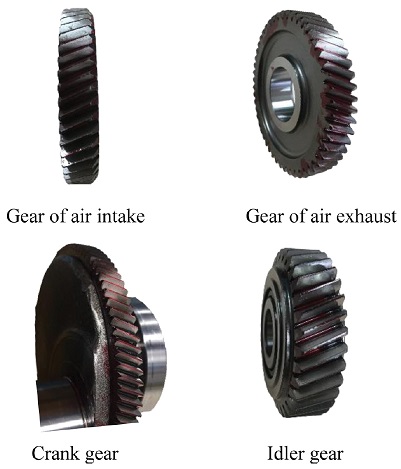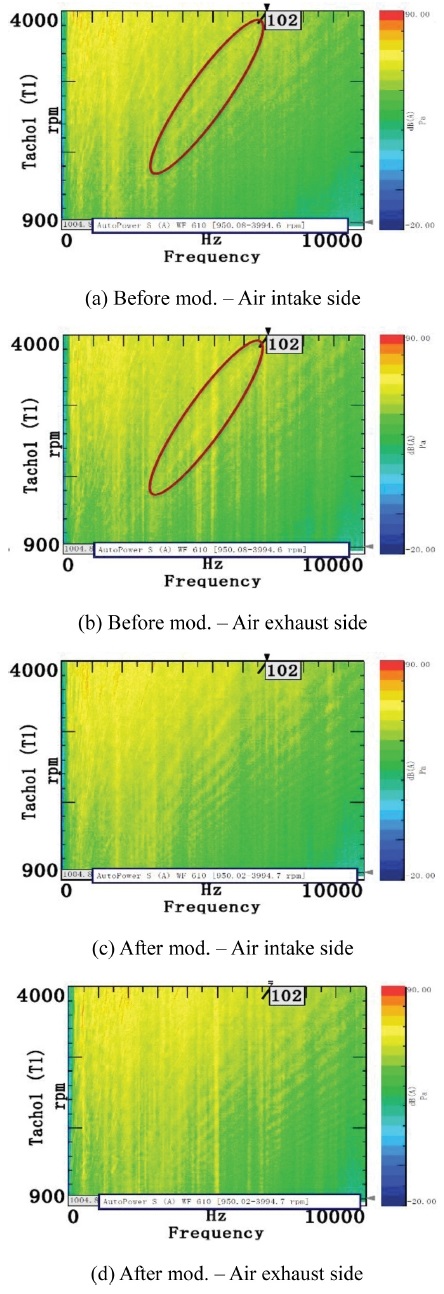
Study on the Reduction of Gear Whine Noise in Diesel Engine Gear Train
1Shuanghuan Driveline Co., Ltd.2School of Mechanical & Aerospace Engineering, ReCAPT, Gyeongsang National University
2경상대학교 기계항공공학부, 항공연
Copyright © The Korean Society for Precision Engineering
This is an Open-Access article distributed under the terms of the Creative Commons Attribution Non-Commercial License (http://creativecommons.org/licenses/by-nc/3.0) which permits unrestricted non-commercial use, distribution, and reproduction in any medium, provided the original work is properly cited.
Abstract
Noise, Vibration and Harshness (NVH) is a comprehensive issue of manufacturing quality that gives the purchaser a superficial feeling. The NVH performance of the vehicle has undoubtedly become an important factor and basis for consumers. When the internal combustion engine is working, it generates a strong noise thus making it necessary to reduce the vibration and noise. The noise of diesel engine is divided into acoustic and structural radiation noise according to different radiation paths. The structure radiated noise is mainly caused by the combustion noise and mechanical transmission noise, while mechanical transmission noise is mainly generated by the meshing gears in the diesel. This paper aims to solve the problem of a diesel engine abnormal gear whine noise under idling conditions with a combination of simulation and experiment. By gear micro-modification, the gear train whine noise is reduced by minimizing the PPTE of the gear train. The comparison of the simulation to benching testing shows a good correlation. It provides an optional solution to the modification proposal of the engine gear train, which uses the similar structure for the engine. Future work will dwell on a better understanding of the gear rattle noise, which will be discussed later.
Keywords:
Diesel engine, Whine noise, Tooth micro-modification키워드:
디젤엔진, 와인소음, 치형 수정1. Introduction
With the development of the vehicle industry, people's living standards have been improved, and it is increasingly hoped that vehicles will have superior performance and excellent quality. Noise, Vibration, and Harshness (NVH) is a comprehensive issue of manufacturing quality, it gives the purchaser the most direct and superficial feeling, the NVH performance of the vehicle has undoubtedly become an important factor and basis for consumers.
When the internal combustion engine is working, it generates strong noise. No matter what kind of occasion it is used, the reduction of vibration and noise is an important issue. For diesel engine designer, controlling and reducing diesel engine noise are the important quality evaluation indicators, which getting more and more attention.1-3
The noise of diesel engine can be divided into acoustic noise and structural radiation noise according to different radiation path. Structure radiated noise is mainly caused by combustion noise and mechanical transmission noise, while mechanical transmission noise is mainly generated by the meshing gears in the diesel. Since the diesel engine gear is cantilever mounted, there is a gap between the two meshing teeth. When the teeth are engaged, due to the instantaneous alternating impact load, rolling and sliding occur at the meshing position. The gear is deformed, vibrated, and the excitation gear generates noise. The ‘Source-Path-Receiver’ model is useful to understand and address engine noise.4 The model of the engine noise is shown in Fig. 1.
For mechanical sources in the vehicle engine and its sub-systems, gear transmission is widely used component, due to its high efficiency, compact structure, reliable operation, long life, and stable transmission, e.g. timing gear, fuel injection pump, and transmission gearbox and so on. At present, research on vibration and noise of gear trains on vehicles mainly focuses on transmission gearbox.5,6 The experimental studies show that the noise at the front end of the diesel engine mainly comes from timing gear. The researchers have done lots of work in the development of vibration and noise reduction, mainly focused to analyze the noise mechanism of internal combustion engines, and conducted noise testing and noise source identification.7-10
This paper presents the study to solve the problem of a diesel engine abnormal whine noise under idling conditions with a combination of simulation and experiment. First, the diesel engine noise before modification is determined by gear order tracking testing in the semi-anechoic room.11 Then, based on the software, an analytical model of the crankshaft and gear train is established to check and verify the gear tooth micro-modifications (No modification, before modification and after modification). At last, simulation results of gear train are confirmed by noise and vibration measurement on bench testing in the semi-anechoic room. It was determined that the gear micro-modification (after modification) could effectively minimize the transmission error and the overall whine noise of the diesel engine gear train which provides a basis for the design of the engine gear train.
2. Research Background and Noise Source
In order to meet the market demand for improved performance of light trucks and commercial vehicles, the comprehensive advantage of cost performance is highlighted, and the emission requirement of China VI standard is upgraded.12 In view of the above situation, a company plans to develop a 2.0 L diesel engine, mainly for the market of light trucks and vans.
For this diesel engine, the gear train is used to drive air compressor, oil pump and mass balance unit (MBU). The schematic of the diesel engine gear train is shown in Fig. 2, No. 1 is crank gear, No. 2 is the driven gear of air intake shaft, No. 3 is idler gear and No. 4 is the driven gear of air exhaust shaft. MBU is a very practical damping technology,13,14 it would effectively reduce the vibration of the engine, and comfortability of the vehicle would be improved correspondingly. But for the gear train which is used to drive the balancing shafts, the most challenge is to minimize the unpleasant gear noise.
Gear noise of diesel engine is roughly classified in two categories according to the nature of its generation: gear whine and gear rattle.15 Gear whine is a narrow banded and tonal noise at meshing frequency, which is caused by periodic fluctuation of the mating gears. The power spectrum of gear whine shows components at mesh frequency and its harmonics. Gear rattle is a broadband and impulsive noise, which is a result of the repeated impacts between the meshing gear teeth. The actual cause of gear rattle is the angular speed fluctuation of the driving gears as a result of engines speed irregularities.
The method to reduce the noise of the engine gear train is to find and control the main sources of the noise, gear order tracking testing is obtained in a semi-anechoic room. And the color contour plot of diesel engine noise testing before modification in the semi-anechoic room is shown in Fig. 3. Fig. 3(a) is an order tracking testing of air intake side, and Fig. 3(b) is an order tracking testing of air exhaust side. In order to make the testing result clear, the legend scale is modified. And it is clearly found that whine noise and rattle noise are all obvious in this engine gear train.
3. Simulation and Experimental Analysis
In order to inspect the effect of gear micro-modification and reduce the whine noise of the gear train, the gear train of the engine without housing is simply modeled in RomaxDesigner software to investigate the T. E. (Transmission error) under the design torque.16-24 Fig. 4 is the modeling of diesel engine gear train without housing, and Table 1 is the summary of the specification of the gear train.
The gear micro-modifications used to reduce tooth corner contact and dynamic excitation of the gear pair, which effect in gear whine noise reduction. Micro-modifications can also be applied on the involute and lead of gear teeth. In this paper, the input torques are too small for the gear train, contrast to no modification (Without gear micro-modification for the gear train) and before modification (Before mod.), only gear profile crown and lead crown are implemented for the gear of air intake and the idler gear after modification (After mod.). As we known, micro-modification parameters cannot be varied individually to evaluate the sensitivity of the durability and NVH performance, and even ideal designs can rarely be manufactured for mass production. Thus, in order to quickly evaluate the results of the nominal modifications, only nominal values of gear micro-modification are used for this gear pair without the consideration of manufacturing tolerance. And the nominal micro-modification parameters are shown in Table 2.
By simulation of one typical input torque, the PPTE (Peak-to-peak Transmission Error) of the modifications (No mod., before mod. and after mod.) is obtained as shown in Fig. 5. For three meshing gear pairs (1-2, 1-3, and 3-4), only PPTE of the after mod. is reduced mostly at the loaded torque. And gear contact pattern of the modifications (Before mod. and after mod.) by simulation is shown in Fig. 6. For gear contact pattern of before mod. and after mod., along the tooth width direction, both edges receive the balanced load. The contact load distribution of these two modifications shows that the optimized modifications all have avoided edge contact and the load distribution of the after mod. seems better than the before mod. over a wide area of the tooth width.
In order to verify the accuracy of CAE simulation results and acquire gear noise and vibration data, the diesel engine is tested in a semi-anechoic room as shown in Fig. 7. Noise and vibration data are acquired by LMS testing software. Comparison of the color contour plots of diesel engine noise testing between before mod. and after mod. are illustrated in Figs. 8-10. It is the comparison of the order slices (102nd order) of diesel engine noise testing between before mod. and after mod., although the rattle noise of the gear train is still obvious. (Fig. 10), it shows that the whine noise level is improved in dB for the gear train of the engine after gear modification. Fig. 9 is the gear contact pattern in bench testing, it is found that no gear mesh misalignment leads to loaded tooth edge in these four gears. It is possible to conclude that simulation results of after mod. are confirmed by noise measurement and gear tooth contact correlation on bench testing in the semi-anechoic room.
4. Conclusions
In this paper, the transmission of the diesel engine gear train is modeled and analyzed by RomaxDesigner, and through gear micro-modification, the gear train whine noise is reduced by minimizing the PPTE of the gear train. The comparison of the simulation to benching testing shows good correlation. It provides an optional solution to the modification proposal of the engine gear train which uses the similar structure for the MBU of the engine.
5. Future Work
To get a better understanding of gear rattle noise, the following work will be finished and discussed later. (1) If the gear train uses the optimized gear with suitable backlash and the proper clearance of crank shaft bearing, maybe the low rattle noise of the gear train can be achieved.25,26 (2) A common design, like scissors gears with additional springs, can be used to eliminate the backlash, and thus gear rattling noise. The spring design is an important key for a suitable working design. It is necessary to design and evaluate the suitable spring preload.15,27 (3) When the material strength is totally satisfied, the austempered ductile iron (ADI) material is used instead of the forged steel to make the gear with good vibration and noise reduction performance, esp. rattle noise.28,29
Acknowledgments
This study was supported by the Basic Science Research Program through the NRF of Korea (NRF) funded by the MEST (NRF-2013R1A1A2058580) and many thanks from the support of Science Technology Bureau of Yuhuan City.
REFERENCES
-
Kwak, W.-H., Kim, H.-S., Jung, I.-S., Yoo, D.-K., and Kang, K.-T., “NVH Optimization of HMC 3.0 L V6 Diesel Engine,” SAE Technical Paper, Paper No. 2007-01-2371, 2007.
[https://doi.org/10.4271/2007-01-2371]

-
Joshi, Y. V., “Gear Whine Noise due to Deformation-A Case Study,” SAE Technical Paper, Paper No. 2017-01-1122, 2017.
[https://doi.org/10.4271/2017-01-1122]

-
Sobecki, B., Davies, P., Bolton, J. S., and Eberhardt, F., “Perception of Diesel Engine Gear Rattle Noise,” SAE International Journal of Passenger Cars-Mechanical Systems, Vol. 8, No. 2015-01-2333, pp. 1097-1103, 2015.
[https://doi.org/10.4271/2015-01-2333]

- Stirling, E., “Diesel Engine Noise,” MDEC Conference, http://www.mdec.ca/2015/S6P4_stirling.pdf, (Accessed 22 AUG 2019)
- Sopouch, M., Resch, T., and Herster, P., “Analysis of Gearbox Acoustics with AVL EXCITE,” SIA Acoustic Simulation Workshop, 2011.
-
Zhang, Q., Kang, J., Dong, W., and Lyu, S., “A Study on Tooth Modification and Radiation Noise of a Manual Transaxle,” International Journal of Precision Engineering and Manufacturing, Vol. 13, No. 6, pp. 1013-1020, 2012.
[https://doi.org/10.1007/s12541-012-0132-1]

-
Houser, D. R., Harianto, J., Sorenson, J., Lim, T. C., Myers, C., et al., “Case History: Engine Timing Gear Noise Reduction,” SAE Technical Paper, 1999.
[https://doi.org/10.4271/1999-01-1716]

-
Huang, J. C. and Abram, K. R., “Cummins 4B Noise Reduction Anti-Backlash Camshaft Gear,” SAE Technical Paper, Paper No. 1999-01-1761, 1999.
[https://doi.org/10.4271/1999-01-1761]

- Derk, J. R., “Effects of Compliant Geartrains on Engine Noise and Performance,” Sound and Vibration, Vol. 39, No. 4, pp. 26-31, 2005.
- Kotlyar, Y., Acosta, G. A., Mleczko, S., and Guerra, M., “A Field Case Study of ‘Whining’ Gear Noise in Diesel Engines,” Gear Solutions, 2013.
- Jia, Y., “Application of Order-Band Analysis in Gear Whine Noise Diagnostic of Diesel Engine,” Design & Manufacture of Diesel Engine, Vol. 23, No. 1, pp. 26-29, 2017. http://www.wanfangdata.com.cn/details/detail.do?_type=perio&id=cyjsjyzz201701007, (Accessed 29 AUG 2019)
- China Water Risk, “Limits and Measurement Methods for Emissions from Diesel Fuelled Heavy-Duty Vehicle (CHINA VI),” Ministry of Ecology and Environment of the PRC, 2018.
-
Yang, C., Shen, Y., You, Y., and Zhao, F., “Design of Engine Gear-Driven Mass Balance Unit and NVH Performance Optimization,” SAE Technical Paper, Paper No. 2012-01-0890, 2012.
[https://doi.org/10.4271/2012-01-0890]

- Lin, X., Shang, Y., and Wang, J., “Research on the Influence of Balance Shaft on Four - Cylinder Engine Noise and Vibration Property,” Internal Combustion Engine & Parts, No. 6, pp. 27-30, 2016. http://www.wanfangdata.com.cn/details/detail.do?_type=perio&id=nrjpj201606011, (Accessed 28 AUG 2019)
-
Klarin, B., Resch, T., Sessarego, C., Spanu, G., and Lamonaca, G., “Numerical Investigation in a Gear Drive of an Engine Balancing Unit with Respect to Noise, Friction and Durability,” SAE Technical Paper, Paper No. 2015-24-2526, 2015.
[https://doi.org/10.4271/2015-24-2526]

-
Zhang, Q., Zhang, J., Liu, Z., Lv, J., Qin, Z., et al., “Simulation and Experimental Analysis for Noise Reduction of a Scooter Gearbox,” Journal of the Korean Society for Precision Engineering, Vol. 35, No. 8, pp. 777-782, 2018.
[https://doi.org/10.7736/KSPE.2018.35.8.777]

-
Zhang, Q., Wang, G. H., and Lyu, S. K., “Study on Empirical Gear Profile Micro-Modifications for Gear Transmission,” Journal of the Korean Society of Manufacturing Process Engineers, Vol. 16, No. 3, pp. 54-62, 2017.
[https://doi.org/10.14775/ksmpe.2017.16.3.054]

-
Lee, D. G., Qin, Z., Jeon, M. H., Kim, L. S., and Lyu, S. K., “A Study on the Fabrication and Performance Evaluation of Worm Gear Reducer,” Journal of the Korean Society of Manufacturing Process Engineers, Vol. 17, No. 1, pp. 1-7, 2018.
[https://doi.org/10.14775/ksmpe.2018.17.1.001]

-
Jeon, M. H., Kim, L. S., Noh, S. Y., Zhen, Q., Choi, C., et al., “Study on Tooth Micro-Geometry Optimization of Rear Gear Set in 2 Speed Planetary Gear Reducer,” Journal of the Korean Society of Manufacturing Process Engineers, Vol. 16, No. 5, pp. 1-6, 2018.
[https://doi.org/10.14775/ksmpe.2017.16.5.001]

-
Zhang, Q., Zhang, J., Liu, Z. H., Lv, J. H., Qin, Z., et al., “Simulation and Experimental Analysis for Noise Reduction of a Scooter Gearbox,” Journal of the Korean Society for Precision Engineering, Vol. 35, No. 8, pp. 777-782, 2018.
[https://doi.org/10.7736/KSPE.2018.35.8.777]

-
Kim, M. H., Qin, Z., Lee, K. H., Zhang, Q., and Lyu, S. K., “A Study on the Design of Rear Wheel Drive Reducer for Electric Vehicle,” Journal of the Korean Society for Precision Engineering, Vol. 35, No. 6, pp. 571-577, 2018.
[https://doi.org/10.7736/KSPE.2018.35.6.571]

-
Zhang, Q., Zhang, J., Yan, Y. L., Zhu, Q. W., Xu, Z. Z., et al., “A Study on the Design of a Gear Transmission Error Test Rig,” Journal of the Korean Society of Manufacturing Process Engineers, Vol. 15, No. 1, pp. 14-19, 2016.
[https://doi.org/10.14775/ksmpe.2016.15.1.014]

-
Jeon, M. H., Jeon, N. S., Kim, L. S., Cho, S. H., and Lyu, S. K., “A Study on the Gear Tooth Micro-Geometry Optimization of Angle Drive Unit,” Journal of the Korean Society for Precision Engineering, Vol. 35, No. 5, pp. 473-478, 2018.
[https://doi.org/10.7736/KSPE.2018.35.5.473]

- Mcnab, N., Mitchum, G., and Ostergaard, E., “Optimizing Gear Macro and Microgeometry to Minimize Whine and Maximize Robustness for a Diesel Engine Application,” Gear Solutions, 2017.
- Hu, W., “Experiment Research of Noise Control in Gear Train of Diesel Engine,” Modern Vehicle Power, No. 2, pp. 39-43, 2015. http://d.old.wanfangdata.com.cn/Periodical/nrjrypshkz201502009, (Accessed 29 AUG 2019)
-
Bailey, G. and Fussner, D., “A Multi-Variable Experimental Study of Diesel Geartrain Rattle,” SAE Technical Paper, Paper No. 2011-01-1561, 2011.
[https://doi.org/10.4271/2011-01-1561]

- Joshi, Y. V. and Kelleher, J. E., “Gear Train Mesh Efficiency Study the Effects of an Anti-Backlash Gear,” SAE Technical Paper, Paper No. 2014-01-1769, 2014.
- Houser, D. R., “An Experimental and Analytical Comparison of the Noise Generated by Gears of Austempered Ductile Iron (ADI) and Steel Materials,” Gear Solutions, 2017.
-
Lefevre, J. and Hayrynen, K. L., “Austempered Materials for Powertrain Applications,” Journal of Materials Engineering and Performance, Vol. 22, No. 7, pp. 1914-1922, 2013.
[https://doi.org/10.1007/s11665-013-0557-4]


PhD, Senior Engineer in Zhejiang Shuanghuan Driveline Co., Ltd. His research interest is Mechanical System Design & Testing.
E-mail: joe22019@163.com

PhD, Senior Engineer in Zhejiang Shuanghuan Driveline Co., Ltd. His research interest is robotics & Electromechanical Control.
E-mail: yongbowang@gearsnet.com
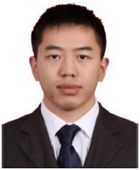
Master, Engineer in Zhejiang Shuanghuan Driveline Co., Ltd. His research interest is Mechanical System Design & Testing.
E-mail: jianhualv@gearsnet.com

Master, Engineer in Zhejiang Shuanghuan Driveline Co., Ltd. His research interest is Mechanical System Design & Testing.
E-mail: jianhualv@gearsnet.com
E-mail: zhonggangzhu@gearsnet.com
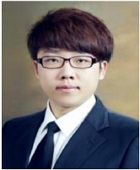
Master Candidate in Department of Mechanical Engineering at Gyeongsang National University. His primary research interest is Mechanical System Design.
E-mail: musicboy163@naver.com

PhD, Professor in Gyeongsang National University. His research interest is Gear, Gearbox, and Mechanical System Design.
E-mail: sklyu@gnu.ac.kr

